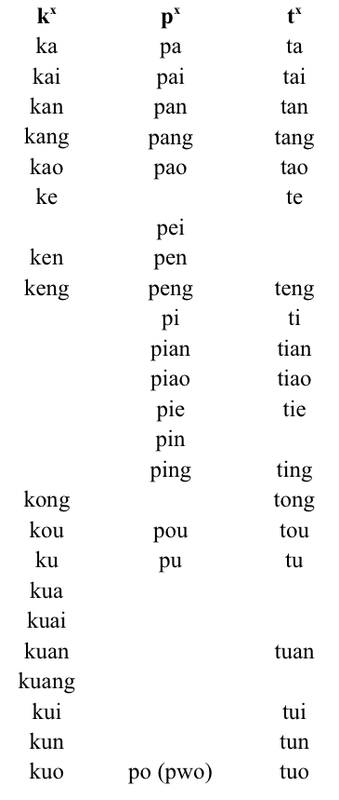Syllable Initials 2
Easy Aspirated Consonants
In the last section, you learned about the Voiceless Velar Fricative, which in Pinyin is represented as an "h" sound. This sound comes up again in Mandarin for what is called "aspirated" consonants. All aspiration means is that you hear this fricative "h" sound in between the consonant and the vowel. So, for example, the syllable "ka" would actually be three distinct sounds in the following order: k...hhh...a.
It's actually better to think of the two consonants as a package deal. Make the first consonant sound, but instead of releasing on a normal vowel sound, release instead on that Cat-hissy, Darth Vader-y, Borat-y sound:
It's actually better to think of the two consonants as a package deal. Make the first consonant sound, but instead of releasing on a normal vowel sound, release instead on that Cat-hissy, Darth Vader-y, Borat-y sound:
|
|
|
|
These three consonants, /k/, /p/ and /t/ are all aspirated in Mandarin. I call them "easy" because all of these sounds exist in English, and we actually do aspirate these sounds on certain words in certain situations. Listen closely to all the possible syllables below and mimic the pronunciation exactly.
ka...kai...kan...kang...kao...ke...ken...keng...kong...kou...ku...kua...kuai...kuan...kuang...kui...kun...kuo
pa...pai...pan...pang...pao...pei...pen...peng...pi...pian...piao...pie...pin...ping...pou...pu...po
ta...tai...tan...tang...tao...te...teng...ti...tian...tiao...tie
ting...tong...tou...tu...tuan...tui...tun...tuo
Easy Aspirated Submission
Now that you are familiar with all the above Mandarin vowel sounds and their pinyin spellings, it's time to narrow down the few sounds that are problematic for you.
Once your account is set up, you will record yourself clearly articulating each of the syllables found on the table below and then email them to [email protected].
Once your account is set up, you will record yourself clearly articulating each of the syllables found on the table below and then email them to [email protected].
- Unlike my fast recordings, be sure to leave a clear space between each syllable so that I can more easily pinpoint it on your uploaded track.
- Read the chart row-by-row, from left to right, working your way down.
- Title your track: Mandarin Syllable Initials Part 2 - Your Name
Once you have successfully submitted your recording, you may move on to the final section: "Difficult Consonants".


